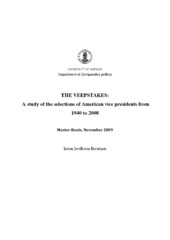The veepstakes: A study of the selections of the American vice presidents from 1940 to 2008
Master thesis
Permanent lenke
https://hdl.handle.net/1956/3776Utgivelsesdato
2009-11-19Metadata
Vis full innførselSamlinger
Sammendrag
American vice presidents have become influential and powerful political figures. Yet, they are not popularly elected; since 1940, they have been personally selected by the presidential nominees themselves. This thesis examines these selections in further detail, seeking to identify which characteristics the presidential nominees look for in a running mate. The reseach question is the following: Which factors explain the vice presidential selections from 1940 to 2008? The theoretical framework for the thesis is a limited one, since the selection of vice presidents has yet to attract much scholarly interest. There are, however, three discernable theories in the literature. First, there is the ticket-balancing theory, representing the traditional explanation on the subject. It expects presidential nominees to select running mates that complement them in some way, come from large states and/or have rivalled them for the presidential nomination. The theory of increased complexity, on the other hand, claims that these traditional selection criteria is only part of the explanation and should be supplemented by a set of modern selection criteria. Finally, the theory of changed dynamics contends that traditional selection criteria no longer govern the selections. Now, the presidential nominees' primary concern is to select a running mate with political experience. The three theories are assessed comparatively, through the use of a conditional logistic regression. The data is provided by Douglas Kriner and Jody Baumgartner. The evaluation of the theories indicates that the ticket-balancing theory has less explanatory power than the two other theories. Thus, the thesis proposes a synthesis model that combines the theory of increased complexity and the theory of changed dynamics. This model shows that presidential nominees generally have chosen ambitious running mates that enjoy much media coverage, whilst they do not pick running mates that rivalled them for the presidential nomination. Also, a difference over time is observable: Prior to 1976, presidential nominees tended to pick running mates from populous states, but the same tendency is not existent after 1972. Lastly, the presidential nominees have probably been conscious of the running mates' genders and ethnic backgrounds: Some have wanted the tickets to be demographically balanced, whilst most would not even consider the possibility of such balance.
Utgiver
The University of BergenOpphavsrett
The authorCopyright the author. All rights reserved
